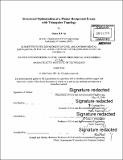| dc.contributor.advisor | Corentin Fivet and John A. Ochsendorf. | en_US |
| dc.contributor.author | Ip, Gerry H. F. (Gerry Hiu Fing) | en_US |
| dc.contributor.other | Massachusetts Institute of Technology. Department of Civil and Environmental Engineering. | en_US |
| dc.date.accessioned | 2016-09-13T19:15:55Z | |
| dc.date.available | 2016-09-13T19:15:55Z | |
| dc.date.copyright | 2016 | en_US |
| dc.date.issued | 2016 | en_US |
| dc.identifier.uri | http://hdl.handle.net/1721.1/104237 | |
| dc.description | Thesis: M. Eng., Massachusetts Institute of Technology, Department of Civil and Environmental Engineering, 2016. | en_US |
| dc.description | Cataloged from PDF version of thesis. | en_US |
| dc.description | Includes bibliographical references (page 65). | en_US |
| dc.description.abstract | Reciprocal frame (RF) structures consist of linear members that are mutually supporting within a closed circuit, enabling spans that are much greater than the length of an individual member. Also known in literature as 'nexorades', these geometrically complex structures offer unique architectural and structural advantages. This thesis explores the topic of structural optimization for a planar RF floor/roof framing structure, focusing on the triangular RF topology. The relative structural performance of the grids is computed and plotted against the geometric parameters for various load cases. The two key parameters studied are the rotation angle of the members which defines the geometry, and the total number of members in the grid which defines the grid density. The load cases modelled include both symmetric and asymmetric loading scenarios on a hypothetical surface supported by the grid, and therefore the loads are distributed to the members based on tributary areas. The goal of this thesis is to determine whether certain geometries will be more favorable across multiple load cases, or whether the optimal geometry would vary greatly. The structural performance is defined by the total strain energy in the grid. Results show that smaller rotation angles at the unit RF level produce more structurally efficient RF grids. Depending on the grid density and load case, the optimal angle lies between 4 and 8.2 degrees. It is found that the optimal angle remains relatively unchanged for a given grid density between the symmetric and asymmetric load cases. | en_US |
| dc.description.statementofresponsibility | by Gerry H.F. Ip. | en_US |
| dc.format.extent | 69 pages | en_US |
| dc.language.iso | eng | en_US |
| dc.publisher | Massachusetts Institute of Technology | en_US |
| dc.rights | M.I.T. theses are protected by copyright. They may be viewed from this source for any purpose, but reproduction or distribution in any format is prohibited without written permission. See provided URL for inquiries about permission. | en_US |
| dc.rights.uri | http://dspace.mit.edu/handle/1721.1/7582 | en_US |
| dc.subject | Civil and Environmental Engineering. | en_US |
| dc.title | Structural optimization of a planar reciprocal frame with triangular topology | en_US |
| dc.type | Thesis | en_US |
| dc.description.degree | M. Eng. | en_US |
| dc.contributor.department | Massachusetts Institute of Technology. Department of Civil and Environmental Engineering | |
| dc.identifier.oclc | 958143308 | en_US |
